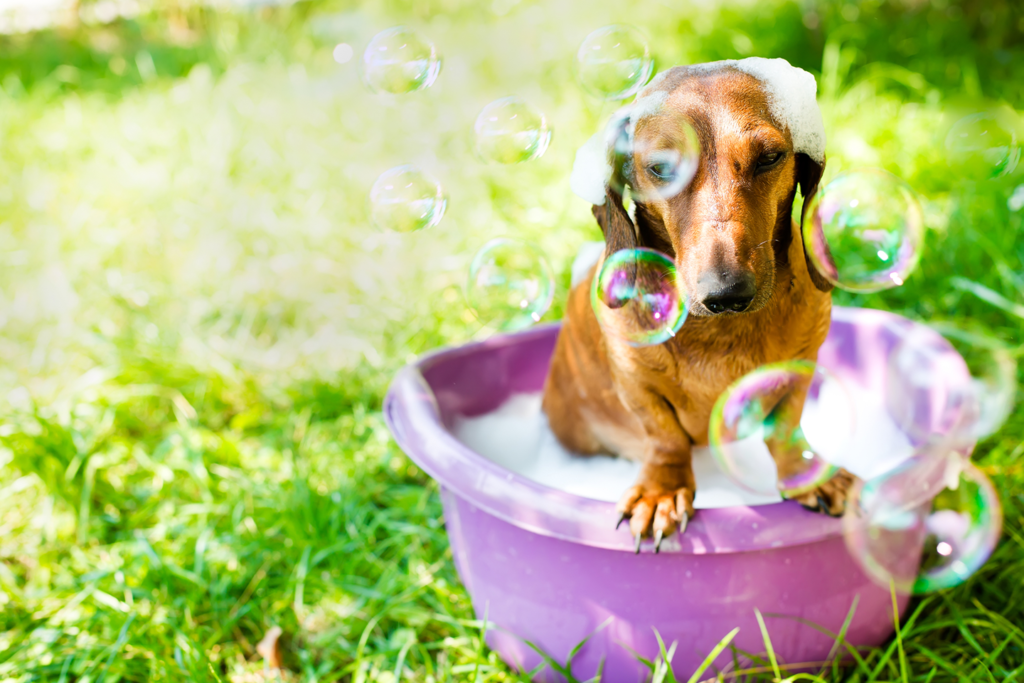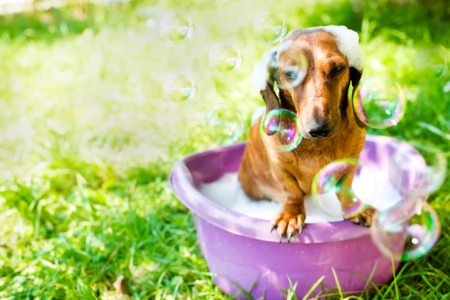Regularly check your dog’s eyes, ears, and teeth for signs of issues, trim their nails monthly, use the right brush for their breed, bathe them regularly with dog shampoo, and inspect their fur for ticks, fleas, or lice. Taking these essential grooming practices will help maintain your pet’s health and keep them clean and comfortable.
Proper grooming is more than just keeping your furry friend looking adorable. It plays a crucial role in maintaining their overall health and well-being. Just like humans, dogs require regular grooming to keep their coat clean, their nails trimmed, and their teeth and ears healthy.
We will discuss five essential dog grooming practices that every pet owner should know. Regularly checking their eyes, ears, and teeth, trimming their nails, using the right brush for their breed, bathing them with dog shampoo, and inspecting their fur are all necessary steps to ensure your four-legged friend’s optimal health. Let’s delve deeper into these practices to understand their importance and benefits for your furry companion.
Importance Of Dog Grooming
Proper dog grooming practices are essential for maintaining the health and well-being of your pet. Regularly checking their eyes, ears, and teeth, trimming their nails, using the right brush, and bathing with dog shampoo helps prevent discomfort and potential health problems.
Maintaining Cleanliness And Hygiene
Regular dog grooming practices are essential for maintaining cleanliness and hygiene in your pet. Dogs, just like humans, accumulate dirt, debris, and bacteria on their skin and fur. By regularly bathing and brushing your dog, you can remove dirt, dead hair, and odors, keeping them clean and fresh. Proper grooming also helps prevent skin infections, hot spots, and bad odors that may arise from poor hygiene.
Preventing Health Issues
Grooming your dog is not just about keeping them clean, but also about preventing health issues. Regular brushing helps distribute natural oils on your dog’s skin, promoting a healthy and shiny coat. Additionally, brushing removes tangles and mats, which can lead to discomfort and skin irritation. Trimming your dog’s nails regularly prevents overgrowth and reduces the risk of painful nail fractures or ingrown nails. By regularly grooming your dog, you can help prevent common health issues and ensure their overall well-being.
Early Detection Of Health Conditions
One of the often overlooked benefits of regular dog grooming is the early detection of health conditions. During grooming sessions, you have the opportunity to closely inspect your dog’s skin, fur, and overall body condition. This allows you to identify any abnormalities such as lumps, bumps, rashes, or wounds that may require further veterinary attention. Early detection of health conditions can greatly increase the chances of successful treatment and prevent potentially serious complications.

Credit: www.facebook.com
Basic Grooming Practices
Grooming your dog is not only important for their appearance but also for their overall health and well-being. Regular grooming helps to maintain cleanliness, prevent infections, and detect any underlying health issues early on. In this section, we will discuss five essential grooming practices that every dog owner should follow to ensure their pet’s health.
Regular Check-ups For Eyes, Ears, And Teeth
Dogs’ eyes, ears, and teeth are prone to various infections and dental diseases. It is crucial to regularly check and clean these areas to prevent any potential problems. Check your dog’s eyes for redness, discharge, or any signs of irritation. Clean their ears gently using a dog-friendly ear cleaning solution and cotton pads. Finally, inspect their teeth and gums for tartar buildup, bad breath, or any signs of dental disease.
Trimming Nails
Trimming your dog’s nails is necessary to prevent discomfort and potential health issues. Long nails can cause pain and even lead to difficulty in walking. It is recommended to trim their nails at least once a month. If you’re unsure about how to do it, consult a professional groomer or veterinarian to avoid injury to your pet.
Using The Right Brush
Using the right brush for your dog’s coat is essential to keep their fur healthy and free from tangles. Different breeds require different types of brushes. For example, long-haired breeds may need a slicker brush or a de-shedding tool, while short-haired breeds may benefit from a bristle brush. Regular brushing not only helps remove loose hair, but it also stimulates the skin and promotes healthy hair growth.
Bathing With Dog Shampoo
Bathing your dog is an important part of their grooming routine. Use a dog-specific shampoo that is gentle on their skin and fur. Avoid using human shampoos as they can cause dryness and irritation. The frequency of baths depends on your dog’s breed and activity level, but generally, bathing once every 4-6 weeks is a good guideline. Remember to rinse thoroughly and dry your dog completely to prevent skin infections.
Inspecting Fur For Parasites
Regularly inspect your dog’s fur for parasites such as ticks, fleas, or lice. These pesky creatures can cause discomfort and transmit diseases to your pet. Use a fine-toothed comb or brush to check for any signs of infestation. If you notice any parasites, consult your veterinarian for appropriate treatment options.
Benefits Of Proper Grooming
Proper grooming practices for dogs offer numerous benefits, including maintaining pet health. Regularly checking eyes, ears, and teeth, trimming nails, using the right brush, and bathing with dog shampoo help keep dogs clean, prevent discomfort, and allow early identification of potential health issues.
Proper grooming practices play a vital role in maintaining the overall health and well-being of your beloved furry friend. Not only does it make them look their best, but it also has numerous benefits that go beyond just aesthetics. In this section, we will explore some of the key benefits of regular grooming for your dog.Decreased Shedding
If you’ve ever found yourself constantly battling with dog hair covering your floors, furniture, and clothes, regular grooming can help alleviate this issue. By brushing your dog’s coat regularly, you can remove loose hair and reduce shedding significantly. This not only keeps your living spaces cleaner but also minimizes allergens in the air, creating a healthier environment for both you and your furry companion.Elimination Of Fleas And Ticks
Fleas and ticks are not only annoying pests, but they can also pose serious health risks to your dog. Regular grooming allows you to check your dog’s coat for any signs of these parasites and take immediate action. By using appropriate dog shampoo and conducting thorough inspections, you can effectively eliminate fleas, ticks, and other external parasites, preventing potential diseases and discomfort for your four-legged friend.Identification Of Underlying Health Conditions
Grooming sessions provide an excellent opportunity for you to closely examine your dog’s skin, coat, ears, eyes, and teeth. Regularly checking these areas allows you to spot any abnormalities or potential health issues early on. From skin infections and allergies to dental problems and ear infections, detecting these conditions promptly can help you seek necessary veterinary care and prevent them from worsening. By taking a proactive approach to grooming, you can be a vigilant pet owner and ensure your dog’s overall well-being. In conclusion, proper grooming practices offer a multitude of benefits for your dog’s health and comfort. From decreased shedding and prevention of parasites to timely detection of underlying health conditions, regular grooming plays a crucial role in maintaining your furry friend’s overall well-being. By implementing these essential grooming practices, you can keep your dog clean, happy, and healthy for years to come.Professional Dog Grooming Tips
Overcoming The Overwhelming Task
Grooming your dog can sometimes seem like an overwhelming task, especially if you are a new pet owner or have a dog with long, thick fur. However, with the right approach and tools, you can easily overcome this challenge and ensure your furry friend stays healthy and happy.
Choosing The Right Tools And Products
When it comes to professional dog grooming, choosing the right tools and products is essential. From brushes to shampoos, each item plays a crucial role in maintaining your dog’s coat and overall health. Here are some tips to help you make the right choices:
- Brush Selection: Different breeds require different brush types. Determine your dog’s coat type and invest in a brush specifically designed for that type. This will help prevent matting and tangles.
- Shampoo Selection: Use a dog-specific shampoo that suits your dog’s skin and coat needs. Avoid using human shampoos, as they can irritate your dog’s skin.
- Nail Trimming Tools: Invest in a good pair of nail clippers or a nail grinder to trim your dog’s nails safely. Regular nail trimming is essential to prevent discomfort and potential health problems.
- Ear Cleaning Products: Use dog-friendly ear cleaning solutions to remove dirt and wax buildup from your dog’s ears. Regular ear cleaning can prevent ear infections.
Proper Brushing Techniques
Brushing your dog’s coat is not only a grooming practice but also a bonding experience. Here are some tips to ensure you brush your dog’s coat correctly:
- Start Slowly: Introduce brushing gradually, especially if your dog is not used to the process. Use positive reinforcement and rewards to make it a positive experience for your dog.
- Brush in the Right Direction: Brush in the direction of hair growth to prevent discomfort and skin irritation. Be gentle, especially around sensitive areas like the face and belly.
- Focus on Problem Areas: Pay extra attention to areas prone to matting, such as behind the ears, under the belly, and around the tail. Use a slicker brush or a comb to remove tangles gently.
Regular Bathing And Drying
Bathing your dog regularly is vital to keep their coat and skin clean and healthy. Here are some tips for a successful bath and drying session:
- Use Warm Water: Make sure the water is warm, but not hot, to avoid discomfort for your dog.
- Use Dog-Specific Shampoo: Apply a dog-specific shampoo and lather it thoroughly. Rinse off all the shampoo to avoid skin irritation.
- Dry Gently: After the bath, use a clean towel or a pet dryer to dry your dog. Be gentle and avoid rubbing the coat vigorously to prevent tangling and skin irritation.
By following these professional dog grooming tips, you can ensure that your furry friend stays healthy, happy, and well-groomed. Remember to be patient, use the right tools, and make grooming sessions a positive experience for both you and your dog.
Faqs About Dog Grooming
Regularly check your dog’s eyes, ears, and teeth for any issues, trim their nails monthly to avoid discomfort, use the appropriate brush for their coat, give them regular baths with dog shampoo, and inspect their fur for ticks, fleas, or lice.
These essential grooming practices help ensure your pet’s health and cleanliness.
Reasons To Regularly Groom Your Dog
Regular grooming is not just about making your dog look good; it is an essential practice for maintaining their overall health and well-being. By regularly grooming your dog, you can prevent various health issues and ensure their coat, skin, and other body parts are in optimal condition. Here are some reasons why grooming is so important: 1. Prevents Matting and Tangling: Regular brushing helps keep your dog’s coat free of mats and tangles. These can be painful for your furry friend and can even lead to skin infections if left untreated. 2. Controls Shedding: Dogs shed their fur, and some breeds shed more than others. Regular grooming, especially brushing, helps remove loose hair and reduces the amount of fur your dog leaves behind in your home. 3. Promotes Healthy Skin: Grooming helps to stimulate the production of natural oils in your dog’s skin, keeping it moisturized and preventing dryness or flaking. It also allows you to check for any signs of skin issues, such as irritations, rashes, or allergies. 4. Manages Nail Length: Overgrown nails can cause discomfort and pain for your dog, making it difficult for them to walk or run. Regular nail trimming prevents this and helps maintain proper foot structure. 5. Checks for External Parasites: Grooming sessions provide an opportunity to inspect your dog for ticks, fleas, or other external parasites. Early detection allows for prompt treatment, preventing infestations and potential health problems.Common Grooming Techniques
Grooming your dog involves various techniques that cater to their specific needs. Here are some common grooming techniques you should consider: 1. Brushing: Regular brushing removes loose hair, prevents matting, and keeps the coat looking healthy and shiny. Different brush types are suitable for different coat types, so make sure to use the right brush for your dog’s breed. 2. Bathing: Dogs need regular baths to keep their coat and skin clean. Use a dog-friendly shampoo and rinse thoroughly to avoid any residue that could irritate your dog’s skin. 3. Nail Trimming: Trimming your dog’s nails prevents them from becoming too long and causing discomfort. Use a dog nail clipper and be cautious not to cut too close to the quick, as it can be painful and cause bleeding. 4. Cleaning Ears: Dogs’ ears can accumulate dirt, debris, and even wax, leading to ear infections. Clean your dog’s ears using a dog-specific ear cleaning solution and cotton balls, ensuring not to insert anything deep into the ear canal. 5. Teeth Brushing: Dental hygiene is vital for your dog’s overall health. Use a dog toothbrush and toothpaste to brush your dog’s teeth regularly, preventing dental issues and maintaining fresh breath.Professional Grooming Vs. Diy Grooming
Deciding whether to opt for professional grooming services or groom your dog at home is a personal choice. Here are some factors to consider: Professional Grooming: – Professional groomers have the expertise and experience to handle different breeds and specific grooming requirements. – They have access to professional-grade equipment and products that may not be available for home use. – Professional grooming can save you time and effort, especially if you have a busy schedule. – Regular visits to professional groomers also provide an opportunity for a thorough health check-up by experienced eyes. DIY Grooming: – Grooming your dog at home can help foster a stronger bond between you and your furry companion. – It allows you to monitor your dog’s health closely and identify any abnormalities early on. – DIY grooming can be more cost-effective in the long run, especially if you invest in the necessary grooming tools and products. Whichever option you choose, remember that grooming is an essential aspect of pet care. Regular grooming not only keeps your dog looking their best but also promotes their overall health and well-being.
Credit: www.facebook.com

Credit: petsthetics.com
Frequently Asked Questions For 5 Essential Dog Grooming Practices For Pet Health
What Are Some Of The General Grooming And Health Care Practices Necessary To Keep A Dog Clean And Healthy?
To keep a dog clean and healthy, regularly check their eyes, ears, and teeth. Trim their nails once a month. Use the right brush for their breed. Bathe them regularly with dog shampoo. Inspect their fur for ticks, fleas, or lice.
Why Is Grooming Essential For Pets?
Proper pet grooming eliminates shedding, ticks, fleas, and improves overall health. Grooming helps identify underlying conditions early and keeps your pet cute and healthy.
What Kind Of Grooming Does My Dog Need?
To keep your dog clean and healthy, regular grooming is essential. Check their eyes, ears, and teeth regularly. Trim nails monthly to prevent discomfort. Use the right brush for their fur. Bathe them regularly with dog shampoo. Inspect their fur for ticks, fleas, or lice.
What Is Pet Basic Grooming?
Pet basic grooming includes regular check-ups of the eyes, ears, and teeth, trimming nails, using the right brush, bathing with dog shampoo, and inspecting fur for ticks, fleas, or lice. It is essential for maintaining a dog’s physical health and can help identify underlying conditions early.
Conclusion
Keeping your dog clean and healthy is essential for their overall well-being. By following these 5 essential dog grooming practices, you can ensure that your pet stays happy and healthy. Regularly checking their eyes, ears, and teeth, trimming their nails, using the right brush for their breed, bathing them with dog shampoo, and inspecting their fur for ticks, fleas, or lice are all important steps in maintaining your dog’s health.
By practicing these grooming habits, you can prevent potential health issues and keep your furry friend looking and feeling their best. Remember, a clean and well-groomed dog is a happy dog!







